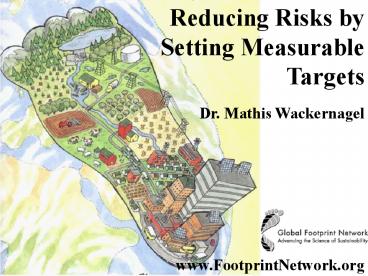Footprint - PowerPoint PPT Presentation
1 / 15
Title:
Footprint
Description:
Reducing Risks by Setting Measurable Targets Footprint Dr. Mathis Wackernagel www.FootprintNetwork.org Bioproductive Segments Median Scenario (UN/IPCC/FAO) EF Used ... – PowerPoint PPT presentation
Number of Views:99
Avg rating:3.0/5.0
Title: Footprint
1
Footprint
Reducing Risks by Setting Measurable Targets
Dr. Mathis Wackernagel
www.FootprintNetwork.org
2
Metabolism like a cow
3
Bioproductive Segments
67 Low-Productivity Ocean
Bioproductive segments
22
4 Biologically Productive Ocean
11 Deserts, Ice Caps and Barren Land
18 Biologically Productive Land
4
Personal planetoid
Global average availability of bioproductive Land
Sea 1.9 global hectares/person
5
Footprint components
Fossil Fuel Built-up Waste Food
Fibres
absorption
6
Global Footprint
Global Footprint Accounts (in global
hectares/person, 1999 data)
Ecological Demand (Ecological Footprint) Ecologica
l Supply (Biocapacity) Footprint Areas
for Biocapacity Areas Growing
Crops 0.53 Crop land 0.53 Grazing
Animals 0.12 Grazing land 0.27 Settlements
infrastructure 0.10 Built-up area 0.10 Producing
timber fuelwood 0.33 Forest 0.86 Absorbing
excess CO2 1.07 Harvesting Fish 0.14 Fishing
Grounds 0.14 Total Global Demand 2.29 Total
Global Supply 1.90
Demand Exceeds Supply By 20 gt
7
Footprint time series
Footprint time series
8
Target
9
Median Scenario (UN/IPCC/FAO)
10
EF Used for Scenario Analysis
11
Ecological Debt in 4 Scenarios
12
Shrink Share by Region
13
Implications for continents?
14
What Does this Open up?
- Accounting leads to accountability
- Targets informed by risks associated with
different scenarios - 2 simple choices integrating climate change and
biocapacity - Performance measure
15
Cat on Roman foot
Mathis_at_FootprintNetwork.org
www.FootprintNetwork.org































